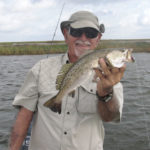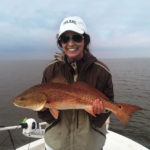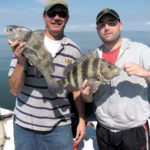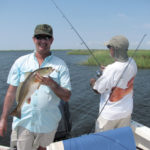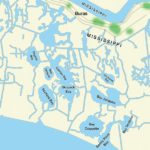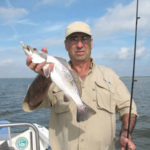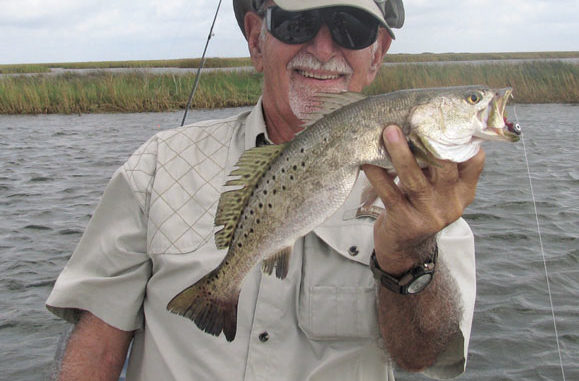
The water won’t be pretty out of Buras this month, but who cares? It’ll be loaded with fish.
Artie’s bellows in the den brought Eddie and Brenda rushing in from the back deck.“What on earth?!” Brenda gasped while stretching over Eddie’s shoulder for a look.
“It’s Archie Manning,” Pelayo laughed while pointing at Artie, whose bellow still echoed in the room, whose face was the same hue as the crawfish piled on the kitchen counter and whose eyes bulged like Luca Brazzi’s during his last moments alive.
The button-buck meatball Artie had tucked in his cheek added much to the Luca look.
“He coulda kept his MOUTH SHUT!” Artie snarled while re-positioning the meat ball with his tongue.
“RIGHT!” Chris yelled at Artie while wiping button-buck meatsauce spittle off his face. “You wouldn’t root for YOUR OWN SON!??”
“Oh, brother,” Eddie laughed. “We’re still on THIS discussion?!?”
Then he and Brenda turned and exited back to the deck.
Here it was early April and the Super Bowl victory buzz was still strong. Watching it again on DVD and on the mega-screen TV in Doc’s Venice camp added greatly to the victory buzz. Our earlier bellows responded to an onside kick, some Shockey and Colston catches — to say nothing of a Porter interception.
Then Pelayo had to bring up Archie Manning, knowing that Artie had it in for the former Saints quarterback since his Ole Miss days. Something about Manning’s record against LSU in those days. Throughout the ’70s, Artie was a serious Who-Dat — but one of those with a lingering grudge against the Saints quarterback. We all remember such fans.
“Game” over, we all walked on the back deck, where Doc reclined in his deck-chair, grabbed his guitar and started picking an old but familiar riff.
“Hummmm? What is that?” Eddie asked with his head cocked. “Sounds real familiar.”
“First song I learned on the guitar,” Doc smiled after a slug on his margarita. “Actually the third, after Gloria and Louie Louie.
“How ’bout Satisfaction?” Pelayo asked.
“Right!” Doc laughed as Trisha squeezed onto his lap. “Maybe it was the fourth.”
Then he started singing it: “Well I love that dirty water….unh-hunh, Boston you’re my home!”
“That’s it!” Eddie yelled. “Dirty Water … by the … the … the?”
“The Standels!” snapped Pelayo, as Chris and Eddie moved in to high-five him.
Then we all, male and female, chimed into the lyrics karaoke-style.
“Frustrated women … I mean they’re frustrated — have to be in by 12 o’clock…”
“Speak for yourself, Brenda!” Trisha laughed and winked from Doc’s lap.
“And speaking of which,” Doc said while putting down his guitar and discreetly moving Brenda’s hand. “You guys still going fishing in the morning?
“You guys must really love that dirty waw-da, as the song says. Not me, I’m sleeping in. Gotta go waaaay downriver to find pockets of clear waw-da with this high river this time of year, over to the mouths of Rafael, Dennis passes, over to coastline around Blind and Redfish bays. I ain’t up for such a haul. I came down to relax this weekend. Weather was too nice to stay home.”
“Of course we’re going tomorrow,” Pelayo snapped. “But we ain’t taking no butt-bashing, gas-guzzling haul downriver.
“We’ll be scooting right down Red Pass, hanging a right at its mouth, up that canal, north through Bay Tambour into the Bay Jacques-Coquette area. A shorter haul from here than your usual spring haul to Stone Island from your Delacroix camp. And watch what we bring back for tomorrow night’s fish fry!”
Chris and Eddie again moved in for a high-five.
“Heck it’s shorter than your usual winter-fishing haul to Oak River!” added Chris. “And a much surer bet for catching.”
Nowadays, the bays once known as Jacques, Skipjack and Coquette are all pretty much one big open bay. Only a few little islands and remnants of spoil banks mark their old boundaries and the canals that crossed them. Sometimes nothing marks the bigger channels. You travel over open water, and suddenly watch your depth finder hit 20 feet as it marks an old channel, a Bayou Jacques or Coquette for instance. Then it goes back to showing 4-foot depths, then 3-foot, then 2, then — WRUUUUN! … WHOA!!
And everybody’s tumbling around the boat when you run aground on oysters. Watch it down here. Better yet, only fish this area during the high tides (and falling for best fishing) and with brisk southeast winds. That’s how we keep prop damage to a minimum — not that we avoid it completely.
The aerial photo maps are great for fishing this area, but so are the ancient ones. The ones that show this marsh when it looked like the Biloxi Marsh — bayous, potholes, bays etc. Those old ones often mark where an old channel lies, or an old reef. These old reefs and channels usually mean edges and ledges invisible from the surface nowadays — hence underwater structure, hence fish.
And amazingly, the fishing hasn’t changed dramatically since the area went from bona-fide marsh to mostly open water. It’s still top-notch down here this time of year. The bottom was always heavy with oysters down here. Two “boxes” were a cinch on every trip.
Cork fishing with the classic shad rig or smoky shrimp-tail (remember them?) tipped with shrimp yielded reds, drum, flounder and sheepshead from every grassy point. School specks clobbered the same offerings around the oyster poles in the bays when the water cleared up a bit.
You almost couldn’t miss. If the trout weren’t turned on, the reds would still cooperate. If the reds weren’t immediately hungry, the flounder, puppy drum and sheepshead took up the slack until the bronzebacks turned on. Even on the worst days, every spot produced at least a few fish.
In the Bay Jacques-Tambour-Chicharas- Coquette area, even in April, even with the river at its highest and those brutal southeast winds pushing dirty river water into this area, even with the wind churning the open water into chocolate milk, even with all this, we catch fish. And on nothing more than the classic popping cork/beetle and dead shrimp combo. Indeed we seem to have the best fishing in this area precisely this time of year. By the dog days of summer, it slows down dramatically.
Look at a map, and you’ll see why pockets of clearish water can be found in this area. What used to be Bays Jacques and Chicharas are shielded from the worst of April’s southeast winds by the little sliver of marsh still left in this area. Bayou Grand Liard, an ancient distributary of the Mississippi, still has a little high ground along its banks (but it’s going fast). This forms a shield of sorts from the east winds so prevalent in the spring around here.
East of Grand Liard the water’s fresher with fewer oysters. Old timers still tell you to always fish a hard bottom. I think they’re on to something. Little crabs, minnow, eels, etc. hide in the crevices between the oysters — especially those little stone crabs. Open up the belly of a redfish caught in this area, and you’ll usually find it crammed with little stone and blue crabs.
Save the spoons for clearer water — the Hopedale-Biloxi marsh, Delacroix-Reggio, Lafitte-Larose type areas, where there’s usually at least a foot of visibility. Down here in this murky stuff, they want dead shrimp on a highly-visible plastic jig.
This time of the year, a high and falling tide is particularly important in this area. The river is generally at its highest in April, so a rising tide pushes in the filthy river water immediately offshore. Come on a rising tide, and you’ll search the area in vain for even a few pockets of semi-clear water. When it’s falling, it’s coming out of the upper section of marsh, the area around the Buras Canal, and out of those few ponds still left. And this is what passes for clear water around here.
You’ll spot the little rips during the falling tide as this clear water comes down from the upper marshes and ponds and clashes with the river water. An offshore rip always means fish. An inshore rip means much the same, in our experience. For us, this simplifies the fishing. Find the clear water, and you generally find the fish. Down here, clear means about 4 or 5 inches of visibility. If you can see your prop, it’s beautiful.
And find a point or the mouth of a trenasse with the current moving, and chances are you’ll find flounder too. Rather than a stalker like the speck and red, the flounder is an ambusher. He lies in wait, allowing the current to bring prey within range. These current-washed points serve as his food plot.
Get out a bit deeper, closer to a main channel where the water dips down to 2 1/2 or 3 feet, and the school specks might be smacking shrimp. Black-headed gulls hovering or simply poised in the water like a flock of dos gris (a few still around down here this time of year), often give them away.
“There’s the rip!” is usually an offshore-fishing exclamation, but Pelayo seemed as excited yelling it here as bellowing it 30 miles offshore on tuna trips. Indeed, the current line was visible near an old spoil bank that borders Bay Jacques. The water went from a cloudy khaki color to a not-quite-so-cloudy khaki color. Just what we were looking for. The diving gulls clinched it.
Pelayo hauled back on the gas, and we idled toward the action.
First stop was the mouth of Bayou Coquette, where it meets Bay Jacques. I peeked astern. Yep I could barely make out the top of the prop through the hazy water.
“It’s fishable,” I announced.
Just then a tern smacked the water around the little eddies formed by the outgoing current about 20 yards astern.
“Saw that?” Pelayo said as his cork sailed toward the action.
I turned to see another tern smack near shore then. In seconds Pelayo’s pole bowed deeply as the trout hit the surface in a gill-rattling frenzy.
“There he is!” Pelayo roared. “They’re turned on, right on schedule!”
Eddie cast, and his cork plunged on its third pop. Up came another school speck, thrashing the surface. For the next half hour, we caught school trout on about every second cast. Without shrimp, it would take about three or four. And without a cork — nothing.
We nailed about two dozen specks, then roared north toward some little tufts of marsh grass that are the remnants of a spoil bank of a canal that ran between Bays Jacques and Chicharas. The canal was bisected by a deep bayou, visible on old maps, and two little rock dams mark the spot.
The depth finder suddenly went down to 15 feet from 3. Here was our spot, the kind that produces just about anywhere in our coastal marshes: a ledge close to a grassy current-washed point. I aimed my shrimp-tipped beetle at a wave-lapped section of marsh grass right next to the rocks. Splish … pop-pop. Then it went behind a little wave. It never reappeared. Then the reel started its sweet music.
“RED!” I howled just as he erupted in a foaming copper swirl. “A monster!”
My line was sizzling out when he turned. I stood on the bow, pole overhead, looking for applause. Instead, I saw Eddie beaming as he swung in a flounder, and Pelayo already admiring the box as he dumped in a puppy drum, his second.
Next stop was an eroded area near the mouth of Bayou Jacques. The light east wind pushed little ripples over the grassy shoreline. The place had redfish written all over it.
Is it just us? We always do better when fishing the wave-lapped shore rather than the lee shore. Eddie’s cork landed about 5 feet from shore. A school of finger mullet erupted on his first pop.
“Saw that!?” he said while turning to Pelayo and Chris, which meant he didn’t see his cork vanish. But he felt the tug. “Whoooa!” Eddie roared, and the drag started singing.
The surface erupted, and the fish aimed for the open water — actually for an oyster pole on the way to the open water. Classic big-red tactic. He was following the script perfectly. Not that there was much mystery. Again he thrashed the surface and flashed us his copper flanks and spotted tail. Gorgeous!
“Gotta go 8 pounds!” Pelayo whistled as he watched the wake. Eddie tightened the drag and turned the fish before it reached the oyster pole. Then I heard Chris grunt on my left, and saw his pole dip.
“Ready for the net, Mr. Eddie?” I roared.
“Yeah!” he huffed. “He’s coming in — look at the size of him!”
Had to go 7 pounds. Maybe 8. What a sight. But then he saw the net — Whoooom! Eddie’s drag started singing again. He grimaced and gripped the rod a little higher. Now he was pumping again. Another spool-sizzling run. More surface-thrashing. Now he was on his side, gasping. The net slid under him, and he came aboard to a chorus of whoops and high-fives.
He measured 25 inches. Fancy fishing guides in the Florida Keys go bonkers if they catch ONE of these a DAY. And now, from the looks of it, Pelayo had another.
I baited my white beetle with shrimp, and cast right where Eddie had nailed his. (For whatever reason, nice reds, 3- to 7-pounders, seem to hang out in pairs or trios down here.) And sure enough, before my first pop, the brute struck.
“YEAH-YEAH!” I howled while rearing back and feeling that solid weight, then that lunge that set my reel screaming, then the run that stripped off 20 feet of line.
I boated mine (about a 7-pound red) as Chris set the hook on his second, which turned out to be a nice puppy drum. Then he cast out to the same oyster-studded, current-washed point and hauled in a chunky sheepshead (he might look like a drum’s kissing cousin, but he’s actually a big pinfish).
Pelayo’s next cast had a fish rattling its mouth frantically right after the strike.
“Trout?!” I howled “Box-a-mixed coming right up!”
“No trout!” yelled Pelayo. “Flounder, podnuh, and a nice one!”
Any flounder is a nice flounder if you ask me. Sure enough, about a 2-pounder slide right into the net at boatside.
Eddie’s next fish kept thrashing on the surface, back and forth, with a few spirited runs mixed in. Classic rat red action, but he looked like a keeper. Pelayo swung him aboard, and he might have gone 4 pounds — no 10-pounder, but ideal for grilling.
Sure enough we ended up at 1 p.m. with nowhere near our limits — but whooping and high-fiving while gazing into our classic “box-a-mixed,” after a rollicking morning of fishing. And we’d seen all of two boats ALL day.
Most people who launch down here this time of year head to the Hospital/Yellow Cotton Bay area or waaaay downriver.
Fine, be our guests.
